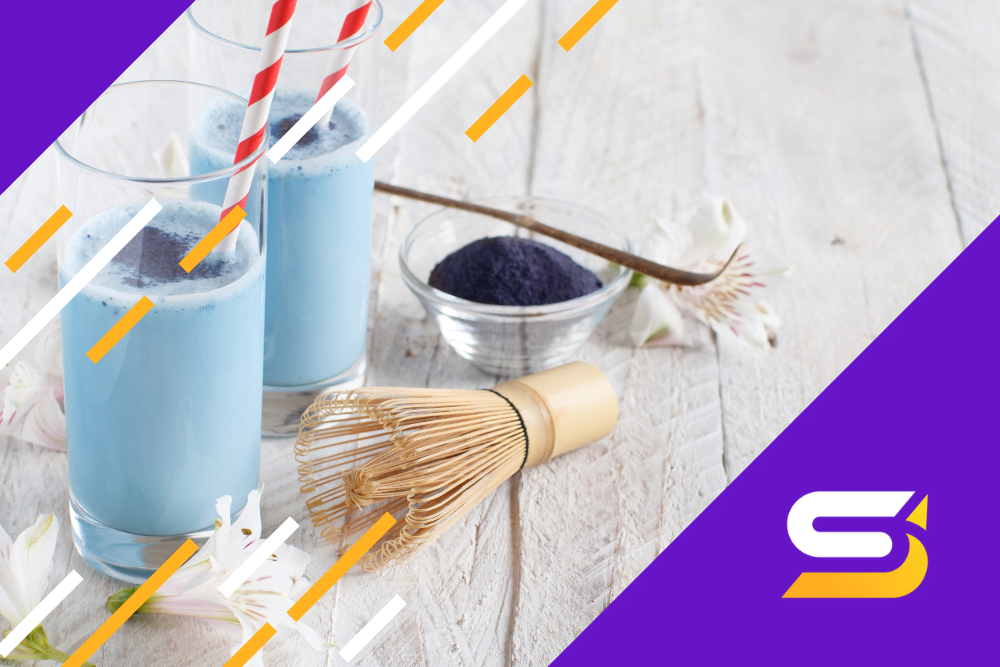What is Blue Matcha?
Blue matcha, a visually stunning and flavorful herbal tea, has been gaining popularity among health enthusiasts and tea lovers. This vibrant blue beverage is made from the Butterfly Pea Flower plant and offers several potential health benefits. This section will explore the origins of blue matcha, how it’s made, and its nutritional properties
Overview of the Butterfly Pea Flower Plant
The Butterfly Pea Flower, scientifically known as Clitoria ternatea, is a plant native to Southeast Asia that produces beautiful deep-blue flowers with yellow markings at their center. This perennial vine thrives in tropical climates and has been used for centuries in traditional medicine practices throughout Asia for its various therapeutic properties.
How is Blue Matcha Made?
Making blue matcha involves drying butterfly pea flowers before grinding them into a fine powder similar to green matcha’s texture (which comes from ground green tea leaves). The resulting powder boasts an intense blue color that can be easily dissolved in water or other liquids to create delightful beverages or incorporated into recipes for added visual appeal.

Nutritional Benefits of Blue Matcha
- Antioxidants: One of the most notable benefits of consuming blue matcha is its high antioxidant content. Antioxidants help protect our cells against damage caused by free radicals – unstable molecules produced during normal metabolic processes or exposure to environmental stressors like pollution.
- Vitamins & Minerals: Alongside antioxidants, blue matcha contains essential vitamins and minerals, such as vitamins A, C, E, and several B-complex vitamins. These nutrients are crucial in maintaining overall health by supporting various bodily functions.
- Fiber: Blue matcha also provides a modest amount of dietary fiber, which is important for digestive health. Fiber helps promote digestive health, reduce cholesterol levels, and regulate blood sugar.

In addition to these nutritional benefits, blue matcha has been associated with several potential health advantages that we will discuss further in the next section.
Blue Matcha is an exciting new form of tea that has become increasingly popular due to its unique flavor and nutritional benefits. With this in mind, let us explore the health benefits of Blue Matcha consumption.
Stress Management
The Butterfly Pea Flower plant, derived from blue matcha, has been used in traditional medicine for centuries to help alleviate stress and anxiety. It contains compounds called flavonoids, known for their antioxidant and anti-inflammatory properties. These properties can help combat oxidative stress in the body, leading to a more relaxed state of mind.
Blood Pressure Stabilization
Research suggests that consuming blue matcha may contribute to stabilizing blood pressure levels due to its high content of anthocyanins – natural pigments with potent antioxidant effects found in plants like the Butterfly Pea Flower. A study published in Oxidative Medicine and Cellular Longevity showed that anthocyanin-rich foods could improve endothelial function, which plays a crucial role in maintaining healthy blood pressure levels.
Skin Health Support
- Anti-aging: The antioxidants in blue matchа protect skin cells from damage caused by free radicals, thus helping prevent premature aging signs such as wrinkles and fine lines.
- Skin hydration: Drinking butterfly pea flower tea regularly can promote skin hydration thanks to its diuretic effect, which helps flush out toxins and excess water from the body.
- Collagen production: The high content of flavonoids in blue matcha may stimulate collagen synthesis, resulting in firmer, more youthful-looking skin.
While these health benefits are promising, research into blue matcha’s effects is still limited. It is vital to sustain a balanced diet and speak with your medical practitioner before altering any daily habits or relying on blue matcha as the main treatment for an ailment.
The health benefits of blue matcha are numerous, ranging from stress management to skin health support. Nevertheless, before drinking this beverage, it is prudent to consider any potential adverse reactions.
Potential Side Effects of Blue Matcha
While blue matcha is a natural and herbal tea, it’s essential to be aware of potential side effects before incorporating it into your daily routine. This section will discuss the caffeine content in blue matcha and its possible interactions with medications and supplements.
Caffeine Content and Sensitivity
Blue matcha contains a minimal amount of caffeine compared to traditional green or black teas. However, some individuals may still experience sensitivity to even low levels of caffeine intake. Symptoms such as jitteriness, increased heart rate, or difficulty sleeping may arise in those sensitive to even low levels of caffeine.
If you suspect you might have an adverse reaction due to caffeine in blue matcha, consider limiting your consumption or opting for a caffeine-free alternative.
Interactions with Medications and Supplements
The Butterfly Pea Flower plant has been used traditionally for various medicinal purposes; however, research on its interaction with modern medications is limited at best. Therefore, you must consult your healthcare provider before consuming blue matcha if you take any prescription drugs or dietary supplements.
- Blood pressure medication: As mentioned earlier in this article (Section 2b), one potential benefit of blue matcha is blood pressure stabilization. If you’re already taking medication for high blood pressure management, consuming butterfly pea flower tea could potentially interfere with the effectiveness of these medicines.
- Diabetes medication: Some studies suggest that butterfly pea flower extract may help lower blood sugar levels by increasing insulin secretion from pancreatic cells (Rat study – source). If you’re taking diabetes medication, discussing with your healthcare provider whether blue matcha suits you is essential.
- Anticoagulant drugs: There have been reports of butterfly pea flower tea potentially interfering with blood clotting (In vitro study – source). Consult your healthcare provider before drinking blue matcha if you take anticoagulants or have a history of clotting issues.
Please note that the studies mentioned above were conducted either in rats or in vitro (outside a living organism). More research is needed to confirm these findings and understand their implications for human consumption. Always consult your healthcare professional if you have concerns about incorporating new herbal teas into your diet, especially if taking medications or supplements.
Before consuming it, it is important to be aware of the potential side effects of blue matcha. Thus, to get the most out of the blue matcha in terms of flavor and nourishment, it is essential to employ it properly.
How to Use Blue Matcha
Discovering how to include blue matcha into your everyday life can be a great way to experience its distinct flavor and potential health advantages. This section will explore some tips for preparing blue matcha and a few delicious recipes that showcase its vibrant color and taste.

Preparation Tips for Maximum Flavor and Nutrition
- Use high-quality blue matcha powder: As with any tea or herbal infusion, the quality of the ingredients plays a significant role in determining the final taste and nutritional value of your drink. Opt for organic, non-GMO products from reputable retailers like Amazon, ensuring an authentic experience.
- Sift before use: Sifting your blue matcha powder through a fine mesh strainer can help break up any clumps that may have formed during storage, resulting in a smoother texture when mixed with water or other liquids.
- Mix thoroughly: To fully dissolve the powder and release its flavors, whisk it vigorously using a traditional bamboo whisk (chasen) or an electric frother until it becomes frothy on top.
- Add sweeteners sparingly: While many people enjoy adding honey or agave syrup to their drinks made with green tea-based matchas; however, be cautious about over-sweetening beverages containing butterfly pea flower extract since it has natural sweetness already present within itself.

Recipes for Delicious Drinks and Treats
- Blue Matcha Smoothie: Blend one teaspoon of blue matcha powder, one cup of almond milk, half a frozen banana, and a handful of ice cubes for an antioxidant-rich smoothie that’s as delicious as it is nutritious.
- Blue Matcha Chia Pudding: Combine two tablespoons of chia seeds with one cup of coconut milk in a jar or container; then stir in half a teaspoon of blue matcha powder until fully incorporated. Allow the mixture to sit overnight in the refrigerator before enjoying it topped with fresh fruit or nuts.
- Iced Blue Matcha Lemonade: Mix equal parts freshly squeezed lemon juice and cold water; sweeten to taste using honey or agave syrup if desired. Add one teaspoon of blue matcha powder per serving and whisk vigorously until entirely dissolved before pouring over ice-filled glasses garnished with mint leaves for added freshness on hot summer days.

Incorporating these tips and recipes into your daily routine can help you make the most out of your experience with blue matcha while adding variety to your diet. Don’t be afraid to get creative when experimenting with new flavors – who knows what other delicious concoctions await discovery?
Blue Matcha is an amazing and versatile product that can be used to make delicious drinks and treats. With the right preparation tips, you’ll get maximum flavor and nutrition from your blue matcha. Now let’s explore where to find quality products so you can start enjoying this superfood.
Where to Buy Quality Blue Matcha Products
Finding high-quality blue matcha products can be challenging, but we’ve got you covered. To ensure you get the best blue matcha, we’ll discuss some great online retailers and local stores to purchase it from.
Online Retailers Offering High-Quality Options
- Amazon: This popular e-commerce platform has an extensive selection of blue matcha powders from different brands with customer reviews for easy comparison.
- iHerb: iHerb is known for its wide range of health supplements and natural products, including organic butterfly pea flower powder options.
- Etsy: An excellent source for artisanal tea blends featuring butterfly pea flowers or handcrafted blue matchas created by small-scale producers worldwide. Browse their unique offerings on their website by searching “blue matcha.”
Local Stores Carrying Authentic Brands
If you prefer purchasing your blue matcha in person at a local store, here are some suggestions on where to find them:
- Natural Food Stores: These specialty shops often carry a variety of teas and herbal remedies, making it likely they will have quality selections of blue matches available.
- Gourmet Tea Shops offering various premium blue matcha products can be found in many cities. These shops are likely to carry premium blue matcha products.
- Health Food Stores: Health food stores often stock a variety of natural supplements, including herbal teas like blue matcha. Check your local store’s tea section for available options.
Always read the labels carefully and check customer reviews when purchasing online or in-store. Confirm you’re getting the advantages by being precise with your purchase – read labels and reviews.
Frequently Asked Questions for Blue Matcha
Blue matcha, derived from the butterfly pea flower plant, offers various health benefits. It is known to help with stress management due to its adaptogenic properties, stabilize blood pressure levels by acting as a diuretic and vasodilator, and support skin health through its antioxidant content.
Blue matcha, also known as butterfly pea flower tea, has a slightly earthy and floral taste with a subtle sweetness. Some people describe its flavor as mild and slightly reminiscent of green tea, with a slightly bitter aftertaste. Its taste can be enhanced with a squeeze of lemon juice, which can change its color from blue to purple and add a tart flavor. Overall, the taste of blue matcha is unique and may vary depending on the brand and quality of the tea leaves.
A fascinating fact about blue matcha is that it changes color when exposed to acidic substances. When mixed with lemon juice or other acidic ingredients, the vibrant blue hue turns into an eye-catching purple shade.
No, despite its name, blue matcha isn’t technically true matcha. Traditional green tea-based Matcha comes from ground Camellia sinensis leaves; whereas Blue Matcha originates from dried and powdered Clitoria ternatea (butterfly pea) flowers.
The proper term for “blue matcha” is Butterfly Pea Flower Powder or Clitoria ternatea Powder. The terminology “blue matcha” has been adopted mainly because of its similar appearance and preparation methods compared to traditional green tea matcha powder.
Blue matcha does not naturally contain caffeine. It is made from the flowers of the butterfly pea plant, which is caffeine-free. However, some manufacturers may add caffeine to their blue matcha products, so it is important to check the label or ask the manufacturer if you are unsure.
No, blue matcha and green matcha are not the same. Green matcha is made from ground green tea leaves, while blue matcha is made from the petals of the butterfly pea flower. They have different flavors and nutritional profiles.
Blue matcha is a good source of antioxidants and has been traditionally used in Ayurvedic medicine for its calming properties. However, more research is needed to fully understand its potential health benefits.
Blue matcha can be prepared by steeping the butterfly pea flower petals in hot water for several minutes. It can be enjoyed hot or cold, and can also be mixed with other ingredients such as lemon juice or honey to enhance its flavor.
Blue matcha has natural pigments that can potentially stain teeth if consumed in large quantities over time. However, this is not a significant concern for most people who consume blue matcha in moderation.
The butterfly pea flower, also known as Clitoria ternatea, is grown in various countries across the world, particularly in Southeast Asia, including Thailand, Vietnam, Malaysia, and Indonesia. It is also commonly found in India and parts of Africa. The plant is popular for its bright blue flowers, which are often used to make tea and natural food coloring. Additionally, the plant is used for medicinal purposes in traditional medicine practices.
Conclusion
Blue Matcha is a unique and healthy alternative to traditional green matcha. Made from the butterfly pea flower plant, it offers numerous health benefits such as stress management, blood pressure stabilization, and skin health support. While there are potential side effects, Blue Matcha can be enjoyed in various ways with preparation tips and recipes available.
If you’re interested in trying out Blue Matcha, check out Shopper Informer for high-quality online options and at local stores near you!
Tags: Guide















